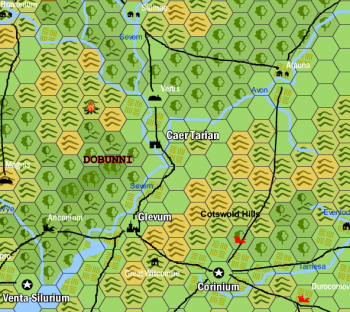Difference between revisions of "Chedworth"
Rigil Kent (talk | contribs) (Created page with "thumb|right|350px|General locale. Each hex is about 6 miles.Chedworth is a royal villa founded about 120 AD, and began as three separate and mo...") |
Rigil Kent (talk | contribs) |
||
| Line 3: | Line 3: | ||
In the early 4th century (Phase III), the villa was transformed into an elite dwelling enclosing the courtyard. The existing wings were linked by a covered portico, and an inner garden and outer courtyard were created. The dining-room (triclinium) received its mosaics and the northern half of the west wing was converted to become a second set of baths. Shortly afterwards (Phase IIIA) the baths in the north wing were rebuilt and changed to dry-heat (laconicum) baths, which meant that the villa had both damp-heat and dry-heat bathing suites. The floors of at least eleven rooms were decorated with fine mosaics. In the late 4th century (Phase IV) the north wing was extended with the addition of a new dining-room. | In the early 4th century (Phase III), the villa was transformed into an elite dwelling enclosing the courtyard. The existing wings were linked by a covered portico, and an inner garden and outer courtyard were created. The dining-room (triclinium) received its mosaics and the northern half of the west wing was converted to become a second set of baths. Shortly afterwards (Phase IIIA) the baths in the north wing were rebuilt and changed to dry-heat (laconicum) baths, which meant that the villa had both damp-heat and dry-heat bathing suites. The floors of at least eleven rooms were decorated with fine mosaics. In the late 4th century (Phase IV) the north wing was extended with the addition of a new dining-room. | ||
| − | [[ | + | [[Vortigern]] owns this village and is a frequent visitor despite the many duties he has as Prydain's high king. |
[[Category:Casus_Belli]][[Category:Casus Belli Locations]] | [[Category:Casus_Belli]][[Category:Casus Belli Locations]] | ||
Revision as of 17:46, 14 September 2015
Chedworth is a royal villa founded about 120 AD, and began as three separate and modest groups of buildings. During this earliest phase (Phase I) the villa consisted of separate buildings to the west and south with a detached bath house to the north. In the early 3rd century (Phase II) the west and south wings were rebuilt following a fire, and the north bath-suite was enlarged with extra rooms added to its eastern side.
In the early 4th century (Phase III), the villa was transformed into an elite dwelling enclosing the courtyard. The existing wings were linked by a covered portico, and an inner garden and outer courtyard were created. The dining-room (triclinium) received its mosaics and the northern half of the west wing was converted to become a second set of baths. Shortly afterwards (Phase IIIA) the baths in the north wing were rebuilt and changed to dry-heat (laconicum) baths, which meant that the villa had both damp-heat and dry-heat bathing suites. The floors of at least eleven rooms were decorated with fine mosaics. In the late 4th century (Phase IV) the north wing was extended with the addition of a new dining-room.
Vortigern owns this village and is a frequent visitor despite the many duties he has as Prydain's high king.
